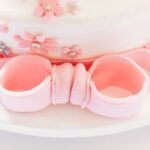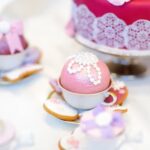Chocolate lovers rejoice. In this article, we will delve into the enchanting world of cake decoration with chocolate. From simple shards and drizzles to intricate 3D figures, chocolate can transform any ordinary cake into a masterpiece.
Its versatility and popularity in the baking world make it a favorite choice for both amateur bakers and professional pastry chefs. Whether you are looking to add a touch of elegance or create a whimsical design, homemade chocolate decorations are sure to wow your guests and elevate your cake to new heights.
The importance of using high-quality chocolate cannot be overstated when it comes to creating decadent cake decorations. The taste, texture, and appearance all rely on the quality of the chocolate used. Inferior chocolate can leave an unpleasant aftertaste and affect the overall aesthetic of your creation.
To ensure the best results, it is recommended to choose premium chocolate brands known for their exceptional flavor and smooth consistency. We will also explore different types of chocolate suitable for various decorative techniques, so you can make informed decisions while experimenting in your kitchen.
Before diving into the art of making chocolate decorations, it is essential to gather the necessary tools and ingredients. From double boilers or microwave-safe bowls to piping bags and parchment paper, having the right equipment will make your journey smoother. Additionally, various types of chocolate such as dark, milk, and white will offer different flavors and colors for endless creativity.
Optional ingredients like food coloring or sprinkles will allow you to customize your designs further. As we walk through each step, we will explain how each tool or ingredient contributes to achieving stunning results.
Get ready to embark on a delectable adventure as we unlock the secrets of crafting beautiful cake decorations with chocolate. In the following sections, we will cover techniques for melting chocolate without mishaps, creating basic yet impressive decorations like shards and curls, mastering piping skills for intricate designs, exploring advanced methods using molds and 3D figures, adding finishing touches with painting and dusting, and ultimately unleashing your creative potential.
So let’s grab our aprons, set up our workstations, and let the magic of chocolate cake decorations begin.
Importance of Using High-Quality Chocolate for Cake Decorations
When it comes to creating cake decorations with chocolate, using high-quality chocolate is of utmost importance. Not only does it have a significant impact on the taste and texture of the final result, but it also plays a crucial role in the overall appearance of the decorations.
High-quality chocolate has a rich and complex flavor that can elevate any cake to new heights. Its smooth and velvety texture allows for easy handling and shaping, making it ideal for intricate designs. On the other hand, inferior chocolates often have a waxy or grainy consistency, which can ruin the desired effect and compromise the overall taste.
To ensure the best outcomes, it is recommended to use premium chocolate brands known for their quality. Look for chocolates with a high percentage of cocoa solids, as these tend to have a more intense and authentic flavor. Additionally, consider experimenting with different types of chocolate such as dark, milk, or white to add depth and variety to your decorations.
Choosing the right type of chocolate for different decorative techniques is also essential. Dark chocolate works well for creating sharp shards or curls that can add an elegant touch to cakes. Milk chocolate’s smoothness and creamy taste make it ideal for drizzles or swirls that will enhance any dessert. White chocolate offers a beautiful contrast against darker cakes and can be molded into intricate shapes or piped onto surfaces for stunning details.
Essential Tools and Ingredients to Get Started
To successfully make cake decorations with chocolate, it is crucial to have the right tools and ingredients. This section will provide a comprehensive list of items needed to get started on your chocolate decorating journey.
Tools
One essential tool for melting chocolate is a double boiler or a microwave-safe bowl. The double boiler method involves placing a heatproof bowl containing the chocolate over simmering water. This indirect heat ensures gentle and even melting without the risk of burning the chocolate. If using a microwave, opt for a microwave-safe bowl and melt the chocolate in short bursts, stirring frequently to prevent overheating.
A spatula is another indispensable tool for working with melted chocolate. It allows you to smoothly spread or mix the melted chocolate. Additionally, piping bags are necessary for intricate designs and shapes. Using different piping tips can help achieve various patterns and effects.
Parchment paper is essential for creating molds, as well as preventing decorations from sticking to surfaces. Scissors or a craft knife will come in handy when cutting shapes out of parchment paper.
Ingredients
When it comes to the type of chocolate needed for cake decorations, there are several options to consider. Dark, milk, and white chocolate all offer unique characteristics and flavors that can be utilized depending on personal preference or design requirements.
For those who prefer vibrant colors in their decorations, food coloring can be added to white chocolate to achieve desired shades. Sprinkles or edible gold dust can also be used to add texture and visual appeal to the decorations.
It’s important always to choose high-quality chocolate as it greatly impacts not only the taste but also the appearance of your final creations. Premium brands tend to have better texture and melt more smoothly than inferior chocolates.
Having these essential tools and ingredients on hand will allow you to embark on your cake decoration journey with confidence and create stunning chocolate decorations that will elevate any cake to extraordinary heights.
Melting Chocolate
Melting chocolate is a crucial step in making cake decorations with chocolate. The melting process determines the texture and consistency of the chocolate, so it is important to follow the appropriate techniques and tips to achieve the desired results. In this section, we will discuss different techniques for melting chocolate and provide step-by-step instructions on each technique.
One common method for melting chocolate is using a double boiler. This involves placing a heatproof bowl over a pot of simmering water, ensuring that the bottom of the bowl doesn’t touch the water. Break the chocolate into small pieces and place them in the bowl. Stir continuously until melted and smooth. One advantage of using a double boiler is that it allows for gentle, gradual heating, which helps prevent overheating or scorching the chocolate.
Another method is using a microwave. Start by chopping the chocolate into small, uniform pieces to ensure even melting. Place the chocolate in a microwave-safe bowl and microwave it at 30-second intervals, stirring well after each interval. Be careful not to overheat the chocolate as it can easily burn or seize up. To avoid overheating, remove the chocolate from the microwave while there are still small chunks left and continue stirring until fully melted.
Alternatively, some bakers prefer using a stovetop method where they melt the chocolate directly in a saucepan over low heat. This technique requires extra caution and frequent stirring to prevent burning or uneven heating.
Now that you know about these different techniques for melting chocolate, it’s time to put them into practice when making your cake decorations. Remember to always use high-quality chocolate for best results and handle it with care during the melting process.
| Technique | Advantages |
|---|---|
| Using Double Boiler | Gentle, gradual heating prevents overheating or scorching |
| Using Microwave | Quick and easy method, but requires careful monitoring to avoid overheating |
| Stovetop Method | Direct heating allows for more control but requires frequent stirring to prevent burning |
Creating Basic Chocolate Decorations
Creating basic chocolate decorations is a great way to add elegance and sophistication to any cake. Here, we will discuss three simple yet stunning chocolate decorations that you can easily make at home: shards, curls, and drizzles. These decorative techniques are perfect for adding texture, height, and visual interest to your cakes.
To create chocolate shards, start by melting your desired type of chocolate using the melting techniques discussed earlier. Once melted and smooth, pour the chocolate onto a parchment paper-lined baking sheet. Use an offset spatula or the back of a spoon to spread the chocolate into a thin layer. For added creativity, you can also mix different types of chocolates together to create marbled patterns.
Next, allow the chocolate to partially set until it’s firm but still pliable. Using a sharp knife or your hands, carefully break the solidified chocolate into angular pieces of varying sizes. You can set these shards onto your cake in various ways: vertically as protruding accents around the sides of the cake or horizontally as a striking top decoration.
Another versatile technique for creating basic chocolate decorations is making curls. Start by pouring melted chocolate onto a cool marble slab or a non-stick surface like an inverted baking sheet. Use an offset spatula to spread the chocolate thinly and evenly over the surface.
Once the chocolate begins to set but is still slightly soft, use a metal bench scraper or palette knife to gently push against one end of the chocolate and scrape it towards you in one fluid motion. This will create beautiful curls with varying shapes and sizes. Transfer these curls onto parchment paper and allow them to fully harden before adding them to your cake.
Drizzling is perhaps one of the simplest yet most visually appealing ways to decorate cakes with melted chocolate. To achieve this effect, melt your preferred type of chocolate using any of the melting techniques discussed earlier. Once melted, transfer the chocolate to a piping bag or a plastic squeeze bottle with a narrow opening.
Hold the piping bag or bottle slightly above the cake and gently squeeze while moving your hand back and forth in a controlled manner. This will create delicate drizzles of chocolate that cascade down the sides of the cake. You can experiment with different patterns and thicknesses to achieve your desired look.
Mastering Chocolate Piping Techniques
Introduction to Chocolate Piping
One of the most versatile and impressive techniques for cake decoration with chocolate is piping. Piping allows you to create intricate shapes, borders, and designs on your cakes, adding a professional touch that will surely impress your guests. Whether you’re a beginner or an experienced baker, mastering chocolate piping techniques can take your cake decorating skills to the next level.
Choosing the Right Equipment
Before diving into the art of chocolate piping, it’s important to have the right equipment at hand. Using a piping bag is the most common method, but you can also use plastic squeeze bottles or even make your own parchment cones. Whichever method you choose, make sure your chosen equipment is clean and dry before starting.
Piping Bag
A piping bag is ideal for creating precise lines and intricate designs. Look for bags that are made of food-grade material and come with different tips or nozzles for various effects. Start with a small round tip (about 2mm) for beginners and experiment with different shapes and sizes as you gain confidence.
Plastic Squeeze Bottles
Plastic squeeze bottles are a great option for those who prefer more control over the amount of chocolate being piped. They are perfect for writing messages or creating simple decorations like dots or lines. Make sure to choose bottles with a narrow nozzle opening for better precision.
Parchment Cone
If you don’t have a piping bag or squeeze bottle on hand, you can easily make your own parchment cone. Cut a triangle from parchment paper, roll it into a cone shape, making sure one corner remains open while sealing the other corners together with tape. Fill the cone with melted chocolate and twist the open end to ensure it stays closed during piping.
Piping Tips and Techniques
Consistency
Having the right consistency of melted chocolate is crucial for successful piping. The chocolate should be smooth and fluid, but not overly runny or too thick. If it’s too runny, it will spread uncontrollably; if it’s too thick, it won’t flow smoothly through the piping bag or nozzle. Adjust the consistency by adding a small amount of vegetable oil or cocoa butter to thin out the chocolate, or powdered sugar to thicken it.
Temperature Control
Maintaining the right temperature is also important when piping chocolate. If the chocolate gets too cool, it will harden quickly and become difficult to work with.
Keep your hands warm while holding the piping bag or bottle by wrapping them in a clean cloth or using heat-resistant gloves. If the chocolate starts to cool down during piping, you can gently warm it up again using a hairdryer on low heat or placing the piping bag in warm water for a short time.
Mistakes and Corrections
Mistakes happen, even to experienced bakers. If you make a mistake while piping chocolate, don’t worry. Simply let the chocolate harden and carefully peel it off from your cake with a small spatula or toothpick. You can then remelt the chocolate and start over without affecting the overall appearance of your cake.
Mastering chocolate piping techniques takes practice and patience, but with time and experimentation, you’ll become more confident in creating beautiful designs that will impress everyone who sees your cake. So grab your preferred equipment, prepare some melted chocolate with the right consistency, and let your imagination guide you as you pipe intricate shapes and borders onto your delicious creations.
Advanced Cake Decoration
When it comes to creating intricate and impressive cake decorations, using chocolate molds and 3D figures can take your skills to a whole new level. This section will introduce you to the concept of using chocolate molds and provide step-by-step instructions on how to create stunning designs and figures for your cakes.
Chocolate molds come in various shapes, sizes, and designs, making them a versatile tool for cake decorators. From floral patterns to intricate lacework, there is a mold available for any theme or occasion. These molds can be made from silicone, plastic, or even metal, depending on personal preference.
To use chocolate molds effectively, start by selecting the appropriate mold based on your desired design. Make sure the mold is clean and dry before proceeding. Then, melt the desired chocolate (dark, milk, or white) according to the techniques discussed in the previous section.
Once the chocolate is melted and smooth, fill each cavity of the mold with chocolate using a spoon or piping bag. Tap the mold gently on a flat surface to release any air bubbles. To create a layered effect or add contrasting colors, fill one layer at a time and allow it to set partially before adding the next layer.
After filling all cavities of the mold with chocolate, place it in the refrigerator or freezer until completely set. The time required for setting may vary depending on factors like room temperature and thickness of the chocolate. Once set, carefully remove the chocolates from the mold by gently flexing it or tapping it against a hard surface.
To create 3D figures using chocolate molds, follow similar steps but fill only certain sections of the mold instead of filling every cavity. Layering different colors can enhance dimensionality and detail in these figures. Once all parts are set and removed from their respective molds, assemble them together using additional melted chocolate as glue.
With these techniques for using chocolate molds and creating 3D figures, you can add an extra wow-factor to your cake decorations. Whether it’s a birthday cake or a wedding cake, these intricate designs and figures are sure to impress everyone. Let your creativity run wild and experiment with different molds and colors to create show-stopping chocolate decorations for your cakes.
| Common Types of Chocolate Molds | Usage |
|---|---|
| Silicone molds | Flexible and easy to release chocolates; ideal for detailed designs and delicate shapes. |
| Plastic molds | Durable and economical; suitable for simple shapes and larger decorations. |
| Metal molds | Extremely sturdy; used for creating intricate designs with sharp edges. |
Incorporating chocolate molds in your cake decorating repertoire opens up endless possibilities for creativity. Whether you choose to make delicate lacework or replicate a beloved cartoon character, the results will be nothing short of impressive. Remember to explore different types of molds, experiment with layering techniques, and let your imagination soar as you create beautiful chocolate decorations for your cakes.
Adding Finishing Touches
Once you have mastered the art of creating chocolate cake decorations, it’s time to elevate your creations even further with some finishing touches. Painting, dusting, and garnishing your chocolate decorations can add a touch of elegance and uniqueness to your cakes. Here are some ideas and techniques for adding those final details that will make your cake truly special:
- Painting Chocolate: Using edible food coloring, you can paint intricate designs on your chocolate decorations. To get started, gather some small paintbrushes specifically designed for food use. Dip them in the food coloring and paint delicate strokes or patterns on your chocolate pieces. You can create beautiful floral designs or hand-painted elements that will impress your guests.
- Dusting Chocolate: Dusting is a technique where you lightly sprinkle shimmer dust or cocoa powder onto your chocolates to add depth and shine. For example, if you have created dark chocolate curls, gently dust them with gold shimmer dust to make them look luxurious and eye-catching. Similarly, you can use cocoa powder to give a velvety finish to white chocolate decorations.
- Garnishing with Edible Flowers or Candy Pearls: Take your chocolate cake decorations to the next level by garnishing them with edible flowers or candy pearls. Choose fresh edible flowers that pair well with the flavor of your cake or go for crystallized flowers for a more elegant touch. You can also use candy pearls or sugar beads in different colors to add texture and visual interest.
Remember to consider the theme or occasion of the cake when planning how to add finishing touches. For example, if it’s a spring-themed cake, opt for pastel-colored food coloring and floral garnishes. If it’s a wedding cake, choose pearls and silver or gold shimmer dust for an elegant look.
By adding these finishing touches to your chocolate decorations, you can truly transform an ordinary cake into a work of art. Get creative and experiment with different techniques and combinations to discover your unique style and make your cakes stand out from the rest. Let your imagination run wild and showcase your newfound chocolate cake decorating skills.
Conclusion
In conclusion, the art of making cake decorations with chocolate is a truly magical and versatile skill to master. By using high-quality chocolate, you can enhance the taste, texture, and appearance of your creations. It is crucial to choose premium chocolate brands that will yield the best results and provide tips on selecting the right type of chocolate for different decorative techniques.
To get started, it is essential to have the necessary tools and ingredients in your kitchen. These include a double boiler or microwave-safe bowl, spatula, piping bags, parchment paper, and various types of chocolate such as dark, milk, and white. Optional ingredients like food coloring, sprinkles, or edible gold dust can also add an extra touch of creativity to your decorations.
Melting chocolate properly is another key aspect to consider. Techniques such as using a double boiler, microwave, or stove each have their advantages and potential pitfalls. By following step-by-step instructions and avoiding common mistakes like overheating or seizing the chocolate, you can ensure a smooth melting process.
From creating basic decorations like shards, curls, or drizzles to mastering advanced techniques such as piping intricate designs or molding 3D figures using chocolate molds – there are endless possibilities for creativity. Don’t forget about adding finishing touches like painting with edible food coloring or dusting with shimmer dust to elevate your decorations even further.
Frequently Asked Questions
How to decorate a cake with just chocolate?
Decorating a cake with just chocolate can be a delightful and simple way to add an elegant touch. Start by melting the chocolate, either in a microwave or on a stovetop, ensuring it reaches a smooth consistency. Once melted, let it cool slightly to avoid melting any frosting on the cake.
Using a piping bag or a plastic resealable bag with the tip cut off, pipe decorative shapes like swirls, rosettes, or flowers directly onto the cake. You can also use small molds to create various chocolate shapes that can be placed on top of the cake. To add additional flair, sprinkle some cocoa powder or grated chocolate over the finished cake for a visually pleasing and delectable treat.
How to make chocolate decorations from melted chocolate?
Making chocolate decorations from melted chocolate is surprisingly easy and adds an impressive touch to any dessert presentation. Begin by melting your desired type of chocolate – dark, milk, or white – and make sure it is smooth without any lumps. Transfer the melted chocolate into a piping bag fitted with a small round tip or simply use a plastic resealable bag with one corner snipped off for more control.
Line a baking sheet with parchment paper and pipe the desired designs onto it: loops, curls, zig-zags, or letters are all great options. Allow the chocolate decorations to set at room temperature until firm before carefully peeling them off the parchment paper and placing them on top of cakes or other desserts as desired.
How to make chocolate sheets for cake decorating?
Crafting chocolate sheets for cake decorating requires some patience but is well worth the effort when you see your beautifully adorned creation come together. Firstly, melt your preferred type of chocolate until it is glossy and smooth. Spread an even layer of melted chocolate over acetate sheets or non-stick silicone mats using an offset spatula or large spoon in sweeping motions. Ensure that the thickness is consistent throughout for best results.
Once spread evenly, allow the chocolate to cool slightly before gently transferring the sheets into the refrigerator to fully harden. After about 10-15 minutes in the fridge, check if the chocolate has transformed into a firm sheet by gently lifting one corner. Carefully remove the hardened chocolate sheets from the mats or acetate sheets and start utilizing them to wrap around cakes, cut into shapes, or create unique designs that will surely impress your guests.

Welcome to my blog about home and family. This blog is a place where I will share my thoughts, ideas, and experiences related to these important topics. I am a stay-at-home mom with two young children. I hope you enjoy reading it! and may find some helpful tips and ideas that will make your home and family life even better!





